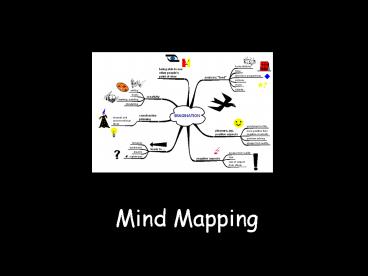Mind Mapping - PowerPoint PPT Presentation
1 / 21
Title:
Mind Mapping
Description:
Describe the main advantages of mind mapping relative to the traditional linear ... Describe several situations in which mind mapping can be usefully applied ... – PowerPoint PPT presentation
Number of Views:4054
Avg rating:3.0/5.0
Title: Mind Mapping
1
Mind Mapping
2
Mind Mapping Overview
- By the end of this lecture you should be able to
- Define mind mapping
- Describe the main advantages of mind mapping
relative to the traditional linear approach to
taking notes - Describe several situations in which mind mapping
can be usefully applied - Outline the main laws of mind mapping
- Outline the main steps in Mind Mapping Organic
Study Technique
3
What is Mind Mapping?
- A non-linear approach for taking notes,
organising thoughts, and generating ideas. - Consists of a central topic image and several
radiating branches containing information about
the central topic.
4
Problems with Traditional Linear Notes
- Obscure keywords
- Inhibit recall
- Waste time
- Prevent associations from forming
5
(No Transcript)
6
(No Transcript)
7
Empirical Evidence
- Lecture Recall Study (Howe, 1977)
- 6 Conditions
- 1. Complete transcript (given)
- 2. Complete transcript (student)
- 3. Sentence summary (given)
- 4. Sentence summary (student)
- 5. Keyword notes (given)
- 6. Keyword notes (student)
- DV Exam performance, verbal performance
8
Mind Map Organic Study Technique(MMOST)
9
MMOST Phases
- 1. Preparation
- 2. Application
10
Preparation Phase
- 4 Sub-Phases
- 1. Browsing
- 2. Setting Limits
- 3. Preliminary Mind Map
- 4. Setting Questions and Goals
11
P1. Browsing
- Casually glance through book, chapter or article.
- Get a feel for
- organisation
- length
- difficulty
- number of tables and figures
- location of summary and conclusion section
12
P2. Set Limits for Time and Amount
- How much time do you want to spend studying?
- massed practice
- distributed practice
- How much information do you want to cover in the
allotted time?
13
P3. Mind Map Current Knowledge
- Take 2 minutes to jot down as much as you can
about the topic being studied.
14
P4. Set Questions and Goals
- What do you want to get out of the chapter or
article? - Gist?
- Detailed understanding of everything?
- Answer specific question?
- Take up to 5 minutes to make a preliminary list
goals and questions. - If necessary, revise questions and goals as you
progress.
15
Application Phase
- 4 Sub-Phases
- 1. Overview
- 2. Preview
- 3. Inview
- 4. Review
16
P1. Overiew
- Generate an overview of the chapter or article.
- Focus on overall structure not detail.
- Dont feel compelled to start on p. 1!
17
(No Transcript)
18
P2. Preview
- Start filling in general details.
- Focus on
- summary and conclusion sections
- beginning and endings of paragraphs
- Dont read everything! Select and reject content
based on your questions and goals.
19
P3. Inview
- Start filling in specific details.
- Level of detail depends on questions and goals.
- Initially skip difficult sections.
- Return later when you have more knowledge
- Easier to understand
20
P4. Review
- Study and reorganise your maps.
- Identify gaps in knowledge, and return to source
to search for specific information. - Test your knowledge by recreating maps from
memory.
21
Mind Mapping Resources
- BOOKS
- The Mind Map Book (Buzan Buzan, 1993).
- Use Your Head. (4th ed., Buzan, 1995).
- SOFTWARE
- MindManager
- http//www.team-link.org
- MindTools
- http//www.mindtools.com/index.html

